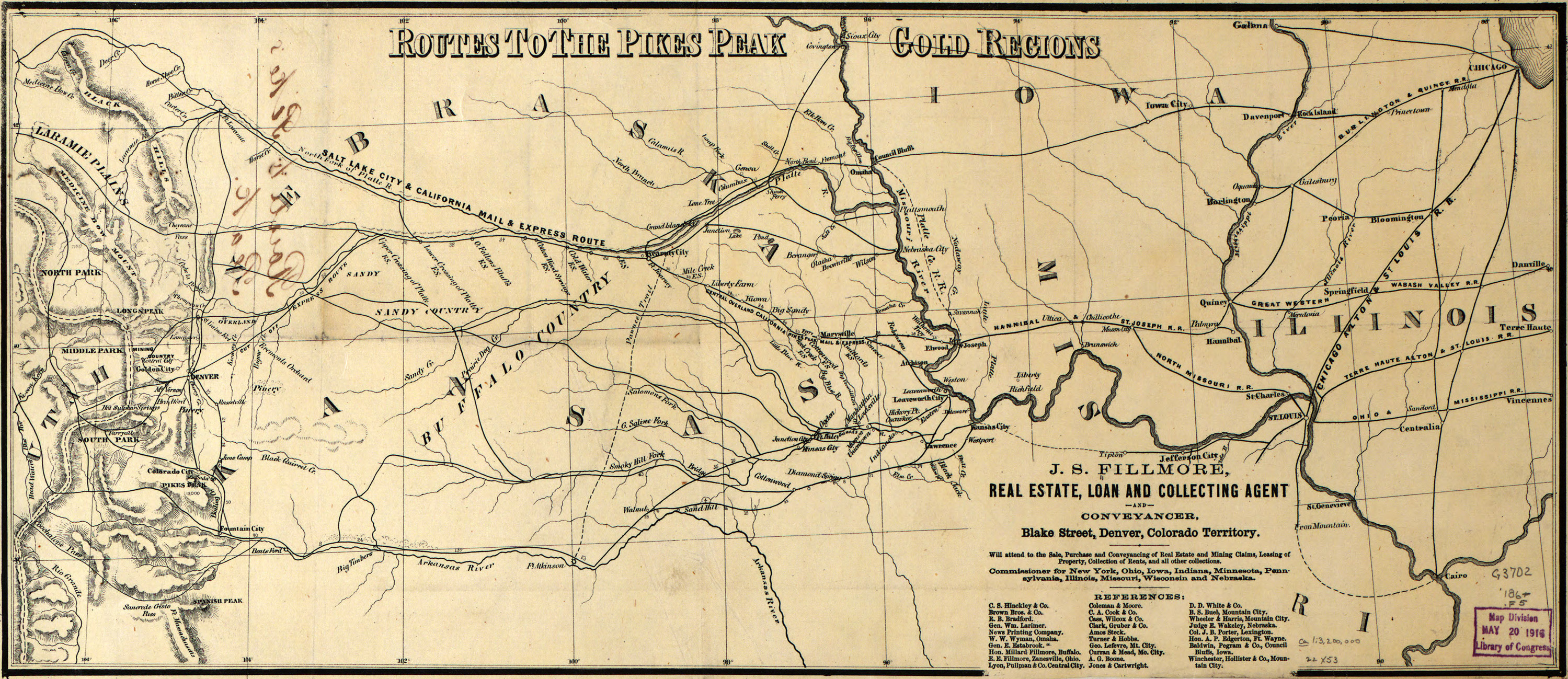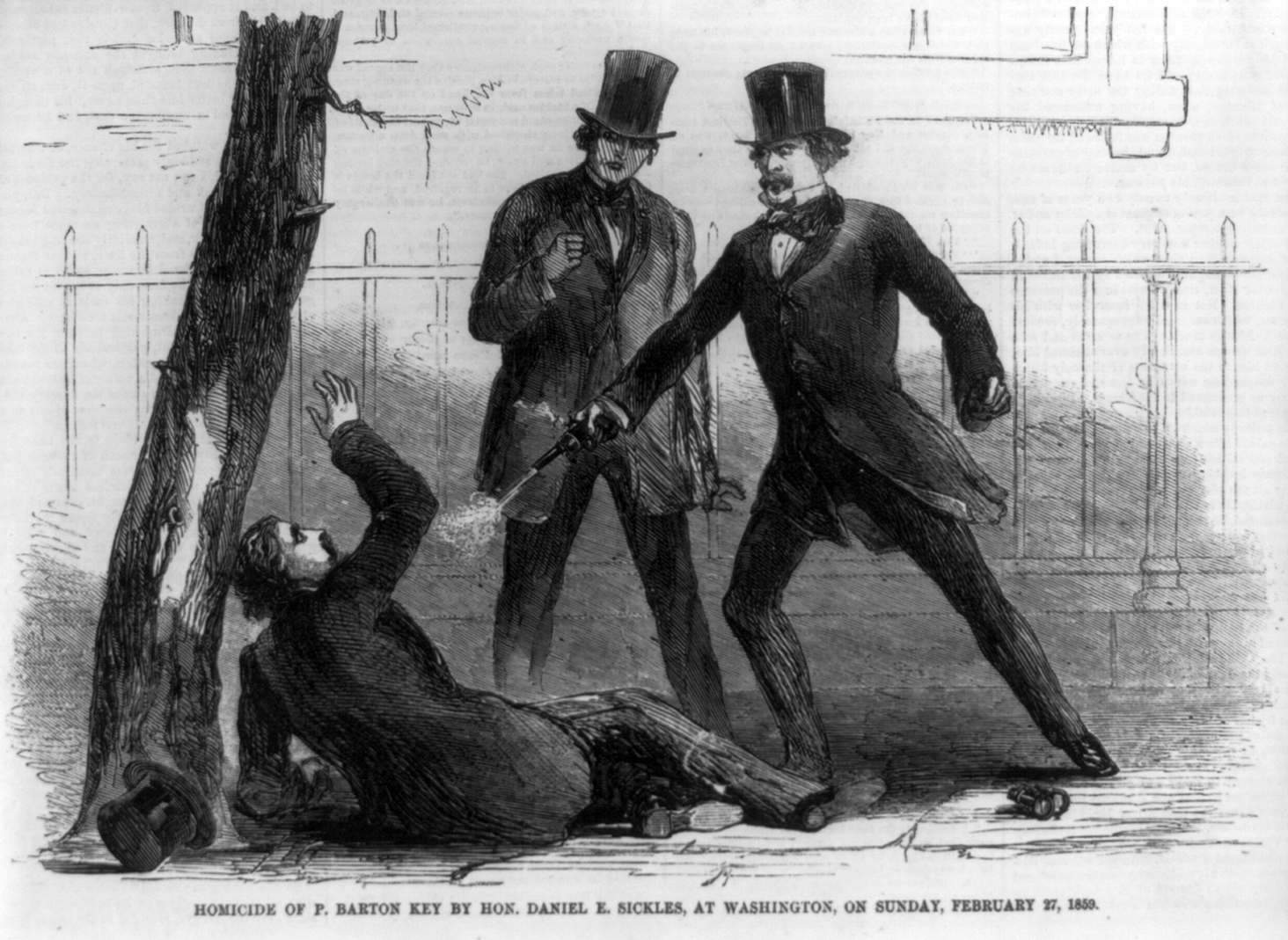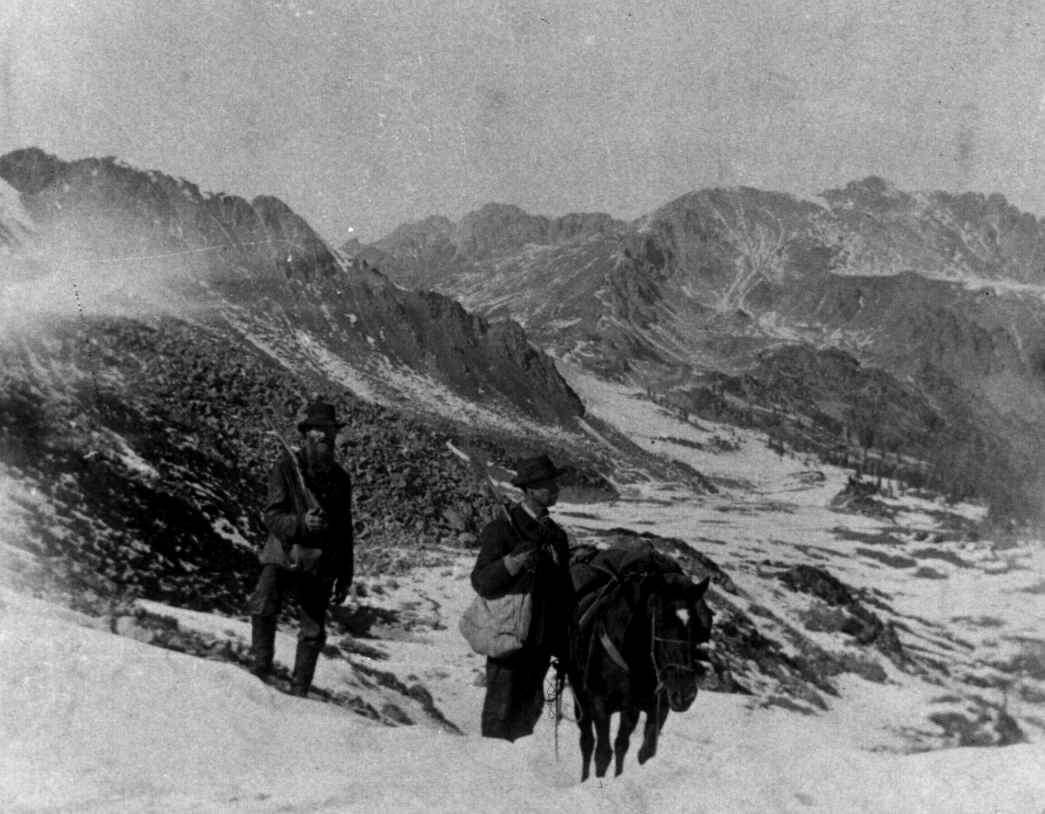|
Fifty-Niners
A "Fifty-Niner" is the term used for the gold seekers who streamed into the Pike's Peak Country of western Kansas Territory and southwestern Nebraska Territory in 1859. The discovery of placer gold deposits along the South Platte River at the foot of the Rocky Mountains in northwestern Kansas Territory by a party of miners led by William Greeneberry "Green" Russell in July 1858 precipitated the Pike's Peak Gold Rush. Many Fifty-Niners took the "Smoky Hill Trail" west through Kansas Territory up the Kansas River valley. The last significant civilian settlement along this route was Manhattan, Kansas, several hundred miles east of the mountains. Between there and the mountains the Fifty-Niners had to cross the unmarked plains, often getting lost, and sometimes confronting Plains Indians. There is no record of how many prospective miners died en route to Pikes Peak. The northern, or Platte River, route followed the Platte River through Nebraska along the Oregon Trail, then angle ... [...More Info...] [...Related Items...] OR: [Wikipedia] [Google] [Baidu] |
Manhattan, Kansas
Manhattan is a city and county seat of Riley County, Kansas, United States, although the city extends into Pottawatomie County. It is located in northeastern Kansas at the junction of the Kansas River and Big Blue River. As of the 2020 census, the population of the city was 54,100. The city was founded by settlers from the New England Emigrant Aid Company as a Free-State town in the 1850s, during the Bleeding Kansas era. Nicknamed "The Little Apple" as a play on New York City's "Big Apple", Manhattan is the home of Kansas State University and has a distinct college town atmosphere. History Native American settlement Before settlement by European-Americans in the 1850s, the land around Manhattan was home to Native American tribes. From 1780 to 1830, it was home to the Kaw people, also known as the Kansa. The Kaw settlement was called Blue Earth Village (Manyinkatuhuudje), named after the river which the tribe had named the Great Blue Earth River, today known as t ... [...More Info...] [...Related Items...] OR: [Wikipedia] [Google] [Baidu] |
Pike's Peak Country
Pike's Peak Country was the name given to the gold mining region of the western United States near Pikes Peak during the Pike's Peak Gold Rush of 1858–1861. The Pike's Peak Country included the region of western Kansas Territory roughly west of the 104th meridian west and the region of southwestern Nebraska Territory roughly west of the 104th meridian west and south of the 41st parallel north. The Pike's Peak Country became the heart of the extralegal Jefferson Territory on October 24, 1859, and the Colorado Territory The Territory of Colorado was an organized incorporated territory of the United States that existed from February 28, 1861, until August 1, 1876, when it was admitted to the Union as the State of Colorado. The territory was organized in the w ... on February 28, 1861. Geography Pikes Peak is located at (38.840560,-105.043890). {{Colorado Former regions and territories of the United States Jefferson Territory Kansas Territory Pikes Peak ... [...More Info...] [...Related Items...] OR: [Wikipedia] [Google] [Baidu] |
Santa Fe Trail
The Santa Fe Trail was a 19th-century route through central North America that connected Franklin, Missouri, with Santa Fe, New Mexico. Pioneered in 1821 by William Becknell, who departed from the Boonslick region along the Missouri River, the trail served as a vital commercial highway until 1880, when the railroad arrived in Santa Fe. Santa Fe was near the end of El Camino Real de Tierra Adentro which carried trade from Mexico City. The trail was later incorporated into parts of the National Old Trails Road and U.S. Route 66. The route skirted the northern edge and crossed the north-western corner of Comancheria, the territory of the Comanche. Realizing the value, they demanded compensation for granting passage to the trail. American traders envisioned them as another market. Comanche raiding farther south in Mexico isolated New Mexico, making it more dependent on the American trade. They raided to gain a steady supply of horses to sell. By the 1840s, trail traffic through th ... [...More Info...] [...Related Items...] OR: [Wikipedia] [Google] [Baidu] |
Colorado Mining Boom
Colorado (, other variants) is a state in the Mountain states, Mountain West subregion of the Western United States. It encompasses most of the Southern Rocky Mountains, as well as the northeastern portion of the Colorado Plateau and the western edge of the Great Plains. Colorado is the List of U.S. states and territories by area, eighth most extensive and List of U.S. states and territories by population, 21st most populous U.S. state. The 2020 United States Census, 2020 United States census enumerated the population of Colorado at 5,773,714, an increase of 14.80% since the 2010 United States Census, 2010 United States census. The region has been inhabited by Indigenous peoples of the Americas, Native Americans and their Paleo-Indians, ancestors for at least 13,500 years and possibly much longer. The eastern edge of the Rocky Mountains was a major migration route for early peoples who spread throughout the Americas. "''Colorado''" is the Spanish adjective meaning "ruddy", th ... [...More Info...] [...Related Items...] OR: [Wikipedia] [Google] [Baidu] |
1859 In The United States
Events from the year 1859 in the United States. Incumbents Federal Government * President: James Buchanan ( D-Pennsylvania) * Vice President: John C. Breckinridge ( D-Kentucky) * Chief Justice: Roger B. Taney (Maryland) * Speaker of the House of Representatives: James Lawrence Orr ( D-South Carolina) * Congress: 35th (until March 4), 36th (starting March 4) Events January–March * January 1 – Minting of Indian Head cent begins. * January 10 – Lucy Cobb Institute opens in Athens, Georgia. * January 28 – The city of Olympia is incorporated in the Territory of Washington. * February 14 – Oregon is admitted as the 33rd U.S. state (''see'' History of Oregon). * February 27 – U.S. Congressman Daniel Sickles shoots dead Philip Barton Key for having an affair with his wife. * March 2–3 – The Great Slave Auction, the largest single sale of slaves in U.S. history, with more than 400 people sold, takes place near Savannah, Georgia. * March ... [...More Info...] [...Related Items...] OR: [Wikipedia] [Google] [Baidu] |
California Gold Rush
The California Gold Rush (1848–1855) was a gold rush that began on January 24, 1848, when gold was found by James W. Marshall at Sutter's Mill in Coloma, California. The news of gold brought approximately 300,000 people to California from the rest of the United States and abroad. The sudden influx of gold into the money supply reinvigorated the American economy; the sudden population increase allowed California to go rapidly to statehood, in the Compromise of 1850. The Gold Rush had severe effects on Native Californians and accelerated the Native American population's decline from disease, starvation and the California genocide. The effects of the Gold Rush were substantial. Whole indigenous societies were attacked and pushed off their lands by the gold-seekers, called "forty-niners" (referring to 1849, the peak year for Gold Rush immigration). Outside of California, the first to arrive were from Oregon, the Sandwich Islands (Hawaii) and Latin America in late 1848. Of th ... [...More Info...] [...Related Items...] OR: [Wikipedia] [Google] [Baidu] |
Pike's Peak Or Bust
The Pike's Peak Gold Rush (later known as the Colorado Gold Rush) was the boom in gold prospecting and mining in the Pike's Peak Country of western Kansas Territory and southwestern Nebraska Territory of the United States that began in July 1858 and lasted until roughly the creation of the Colorado Territory on February 28, 1861. An estimated 100,000 gold seekers took part in one of the greatest gold rushes in North American history. The participants in the gold rush were known as " Fifty-Niners" after 1859, the peak year of the rush and often used the motto Pike's Peak or Bust! In fact, the location of the Pike's Peak Gold Rush was centered north of Pike's Peak. The name Pike's Peak Gold Rush was used mainly because of how well known and important Pike's Peak was at the time. Overview The Pike's Peak Gold Rush, which followed the California Gold Rush by approximately one decade, produced a dramatic but temporary influx of migrants and immigrants into the Pike's Peak Country o ... [...More Info...] [...Related Items...] OR: [Wikipedia] [Google] [Baidu] |
High Plains (United States)
The High Plains are a subregion of the Great Plains, mainly in the Western United States, but also partly in the Midwest states of Nebraska, Kansas, and South Dakota, generally encompassing the western part of the Great Plains before the region reaches the Rocky Mountains. The High Plains are located in eastern Montana, southeastern Wyoming, southwestern South Dakota, western Nebraska, eastern Colorado, western Kansas, eastern New Mexico. The southern region of the Western High Plains ecology region contains the geological formation known as Llano Estacado which can be seen from a short distance or on satellite maps. From east to west, the High Plains rise in elevation from around . Name The term "Great Plains", for the region west of about the 96th or 98th meridian and east of the Rocky Mountains, was not generally used before the early 20th century. Nevin Fenneman's 1916 study, ''Physiographic Subdivision of the United States'', brought the term Great Plains into more w ... [...More Info...] [...Related Items...] OR: [Wikipedia] [Google] [Baidu] |
Landmark
A landmark is a recognizable natural or artificial feature used for navigation, a feature that stands out from its near environment and is often visible from long distances. In modern use, the term can also be applied to smaller structures or features, that have become local or national symbols. Etymology In old English the word ''landmearc'' (from ''land'' + ''mearc'' (mark)) was used to describe a boundary marker, an "object set up to mark the boundaries of a kingdom, estate, etc.". Starting from approx. 1560, this understanding of landmark was replaced by a more general one. A landmark became a "conspicuous object in a landscape". A ''landmark'' literally meant a geographic feature used by explorers and others to find their way back or through an area. For example, the Table Mountain near Cape Town, South Africa is used as the landmark to help sailors to navigate around southern tip of Africa during the Age of Exploration. Artificial structures are also sometimes built to a ... [...More Info...] [...Related Items...] OR: [Wikipedia] [Google] [Baidu] |
Colorado Silver Boom
The Colorado Silver Boom was a dramatic expansionist period of silver mining activity in the U.S. state of Colorado in the late 19th century. The boom started in 1879 with the discovery of silver at Leadville. Over 82 million dollars worth of silver was mined during the period, making it the second great mineral boom in the state, and coming 20 years after the earlier and shorter Colorado Gold Rush of 1859. The boom was largely the consequence of large-scale purchases of silver by the United States Government authorized by Congress in 1878. The boom endured throughout the 1880s, resulting in an intense increase in both the population and wealth of Colorado, especially in the mountains. It came to an end in 1893 in the wake of the collapse of silver prices caused by the repeal of Sherman Silver Purchase Act.Voynick, S.M., 1992, Colorado Gold, Missoula: Mountain Press Publishing Company, Silver had been discovered in Colorado in the 1860s, with early mining in Clear Creek Canyon at ... [...More Info...] [...Related Items...] OR: [Wikipedia] [Google] [Baidu] |
Horace Austin Warner Tabor
Quintus Horatius Flaccus (; 8 December 65 – 27 November 8 BC), known in the English-speaking world as Horace (), was the leading Roman lyric poet during the time of Augustus (also known as Octavian). The rhetorician Quintilian regarded his ''Odes'' as just about the only Latin lyrics worth reading: "He can be lofty sometimes, yet he is also full of charm and grace, versatile in his figures, and felicitously daring in his choice of words."Quintilian 10.1.96. The only other lyrical poet Quintilian thought comparable with Horace was the now obscure poet/metrical theorist, Caesius Bassus (R. Tarrant, ''Ancient Receptions of Horace'', 280) Horace also crafted elegant hexameter verses (''Satires'' and '' Epistles'') and caustic iambic poetry ('' Epodes''). The hexameters are amusing yet serious works, friendly in tone, leading the ancient satirist Persius to comment: "as his friend laughs, Horace slyly puts his finger on his every fault; once let in, he plays about the heartstrin ... [...More Info...] [...Related Items...] OR: [Wikipedia] [Google] [Baidu] |
Buffalo Bill Cody
William Frederick Cody (February 26, 1846January 10, 1917), known as "Buffalo Bill", was an American soldier, bison hunter, and showman. He was born in Le Claire, Iowa Territory (now the U.S. state of Iowa), but he lived for several years in his father's hometown in modern-day Mississauga, Ontario, Canada, before the family returned to the Midwest and settled in the Kansas Territory. Buffalo Bill started working at the age of eleven, after his father's death, and became a rider for the Pony Express at age 15. During the American Civil War, he served the Union from 1863 to the end of the war in 1865. Later he served as a civilian scout for the U.S. Army during the Indian Wars, receiving the Medal of Honor in 1872. One of the most famous and well-known figures of the American Old West, Buffalo Bill's legend began to spread when he was only 23. Shortly thereafter he started performing in shows that displayed cowboy themes and episodes from the frontier and Indian Wars. He foun ... [...More Info...] [...Related Items...] OR: [Wikipedia] [Google] [Baidu] |











